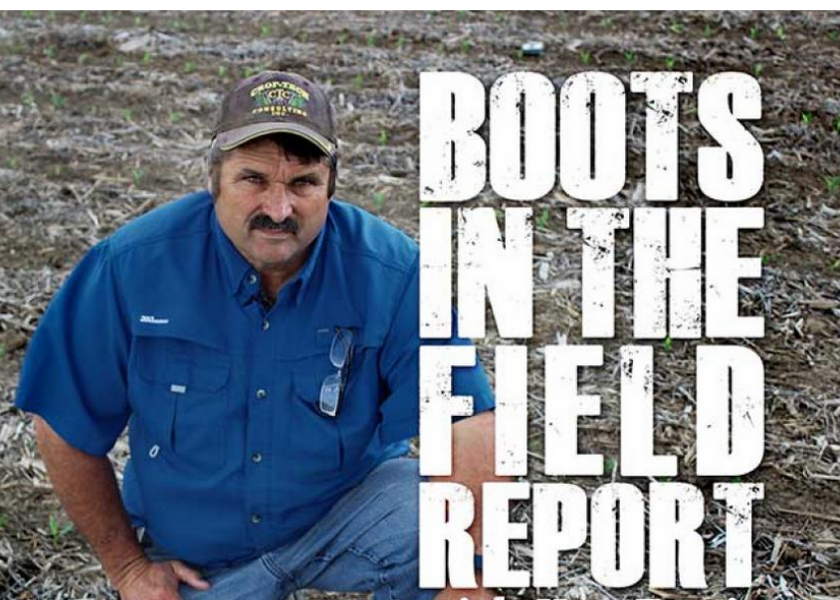Ferrie: 5 Reasons To Not Apply All Your Nitrogen Upfront

Drought or dry conditions are on a lot of farmers’ minds as corn planting season in the Midwest nears. Last week, one Iowa farmer asked Ken Ferrie, Farm Journal Field Agronomist, whether it would be good to put all his nitrogen (N) on upfront and not risk being dry at sidedress time. The farmer’s concern is that, due to dry conditions, the N could get caught at the ground surface and be unable to move down into the corn root system.
Ferrie’s response: “Never plan for a drought, but always use steps to mitigate risk when you can,” he says.
“Drought mitigation is in hybrid selection, in managing plant densities for our light soils,” he adds. “It’s also about trying to farm without soil layers that roots or water can get trapped on.”
Consider these five reasons to not put all your nitrogen on at the front end of the season.
1. The principles of the four Rs can help you mitigate both wet- and dry-year risks. Ferrie says if your current nitrogen plan is not your limiting factor, then changing your plan to make it more efficient will not change yield.
“You may be able to lower your N rate and keep the same yield, and this would improve your ROI and of course improve your environmental footprint,” says Ferrie, owner of Crop-Tech Consulting, near Heyworth, Ill.
2. Consider and avoid these common mistakes. The further out in front you go with a spring N application, the greater the risk you'll lose it before the crop can use it. Fall-applied nitrogen is usually at even more risk than spring applied.
Another common mistake Ferrie sees is farmers opting to move most of their upfront nitrogen to a late sidedress application. What commonly occurs is weather conditions then cause them to make the application too late and they lose yield.
Early-season nitrogen is important for the plant as it is establishing ear size. “While it doesn't take a lot of nitrogen to do this, it needs to be available for the small plant to find,” Ferrie says.
3. From VA to tasseling, make sure corn plants have access to 7 lbs. to 10 lbs. of N per day. The amount of N available at this point is as important as the placement, Ferrie says.
“Even a soil with the ability to mineralize high amounts of nitrogen will not be able to keep up or be able to mineralize enough on a per-day basis to meet the crop needs in that rapid growth,” he says. “If you see a noticeable jump in your corn visually when you sidedress, it's telling you that you didn't have enough on upfront.”
4. From tasseling to black layer most hybrids need about 120 lbs. of nitrogen. While that’s a substantial amount, it equates to only about 2 lbs. per day, Ferrie notes. Still, he cautions farmers to not underestimate the crops’ N needs in this period as it contributes to good grain fill.
“It’s common when growers put all their nitrogen on upfront that they run out in mid-August and lose depth of kernel,” Ferrie says. “If no one is watching and no one checks soil nitrates, this loss may go unnoticed and be blamed on the hybrid or dry weather.”
5. A sound strategy works year in and year out. Ferrie recommends that farmers apply about two-thirds of their nitrogen early and then sidedress the remaining one-third for depth of fill, if you’re using ground equipment.
If you use fertigation, he says to break up those N applications even more, as you’ll be able to evaluate corn stands in the middle of the season and determine how the crop has used applied nitrogen to date and what it needs moving forward.
Ferrie cautions farmers who believe corn needs to turn yellow before nitrogen deficiencies limit yield. That’s a theory that can cause significant yield losses.
“You can have a 20-bushel loss in yield from a lack of adequate nitrogen and not be able to see that from the pickup,” he says. “When we are dealing with nutrients that affect yield, nitrogen is the big dog. And when you run out, yields will drop. Missing P and K will change soil test values, but missing out on nitrogen reduces yields.”'
Get Ferrie's complete recommendations from this week's Boots In The Field Report here:
Think Ahead to get Nitrogen Timing and Rates Right in 2021
Help Crops Fix Nitrogen, Save 25 to 50 Pounds Annually







